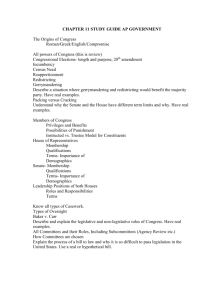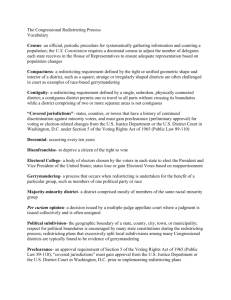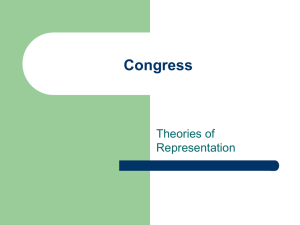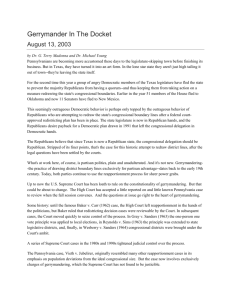Congressional Redistricting Process Overview
advertisement
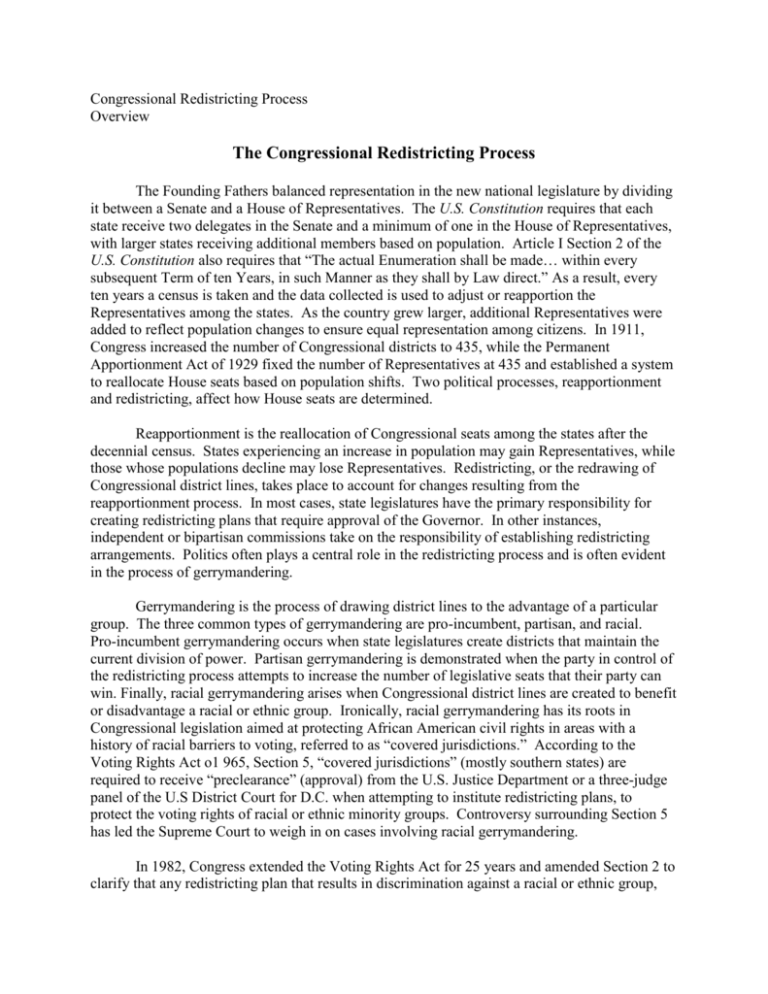
Congressional Redistricting Process Overview The Congressional Redistricting Process The Founding Fathers balanced representation in the new national legislature by dividing it between a Senate and a House of Representatives. The U.S. Constitution requires that each state receive two delegates in the Senate and a minimum of one in the House of Representatives, with larger states receiving additional members based on population. Article I Section 2 of the U.S. Constitution also requires that “The actual Enumeration shall be made… within every subsequent Term of ten Years, in such Manner as they shall by Law direct.” As a result, every ten years a census is taken and the data collected is used to adjust or reapportion the Representatives among the states. As the country grew larger, additional Representatives were added to reflect population changes to ensure equal representation among citizens. In 1911, Congress increased the number of Congressional districts to 435, while the Permanent Apportionment Act of 1929 fixed the number of Representatives at 435 and established a system to reallocate House seats based on population shifts. Two political processes, reapportionment and redistricting, affect how House seats are determined. Reapportionment is the reallocation of Congressional seats among the states after the decennial census. States experiencing an increase in population may gain Representatives, while those whose populations decline may lose Representatives. Redistricting, or the redrawing of Congressional district lines, takes place to account for changes resulting from the reapportionment process. In most cases, state legislatures have the primary responsibility for creating redistricting plans that require approval of the Governor. In other instances, independent or bipartisan commissions take on the responsibility of establishing redistricting arrangements. Politics often plays a central role in the redistricting process and is often evident in the process of gerrymandering. Gerrymandering is the process of drawing district lines to the advantage of a particular group. The three common types of gerrymandering are pro-incumbent, partisan, and racial. Pro-incumbent gerrymandering occurs when state legislatures create districts that maintain the current division of power. Partisan gerrymandering is demonstrated when the party in control of the redistricting process attempts to increase the number of legislative seats that their party can win. Finally, racial gerrymandering arises when Congressional district lines are created to benefit or disadvantage a racial or ethnic group. Ironically, racial gerrymandering has its roots in Congressional legislation aimed at protecting African American civil rights in areas with a history of racial barriers to voting, referred to as “covered jurisdictions.” According to the Voting Rights Act o1 965, Section 5, “covered jurisdictions” (mostly southern states) are required to receive “preclearance” (approval) from the U.S. Justice Department or a three-judge panel of the U.S District Court for D.C. when attempting to institute redistricting plans, to protect the voting rights of racial or ethnic minority groups. Controversy surrounding Section 5 has led the Supreme Court to weigh in on cases involving racial gerrymandering. In 1982, Congress extended the Voting Rights Act for 25 years and amended Section 2 to clarify that any redistricting plan that results in discrimination against a racial or ethnic group, regardless of intent, would be found in violation. The Supreme Court ruled unanimously in Thornburg v. Gingles 478 U.S. 30 (1986) that a North Carolina redistricting plan for the state legislature hampered the efforts of black voters to elect candidates of their choice by dividing them into districts where white voters could easily defeat black candidates. The Court also outlined preconditions for determining if a redistricting plan had discriminatory results. An important impact of the case was the creation of districts where blacks were in the majority. In Shaw v. Reno 509 U.S. 630 (1993), the Court ruled 5-4 that redistricting on the basis of race must face “strict scrutiny” under the equal protection clause of the 14th amendment. The Court determined that the North Carolina Congressional reapportionment plan, although appearing to be racially neutral, resulted in strangely shaped districts that unnecessarily separated voters into districts based on race. In Miller v. Johnson 515 U.S. 900 (1995), the Court again ruled 5-4 that a Georgia Congressional district drawn to create an African American majority was a “geographic monstrosity,” that violated the equal protection clause. Redistricting remains a controversial political process where the losing party or group in any proposed plan often seeks the assistance of state and federal courts to resolve disputes. In 2006, Congress again extended the Voting Rights Act for 25 more years, making it likely that challenges to racial gerrymandering will continue. Reapportionment and redistricting have again come back into the national spotlight after the results of the 2010 census. In Perry v. Perez 565 U.S. __ (2012), the Supreme Court issued a 9-0 per curiam opinion after Texas Governor Rick Perry and state officials appealed a redistricting map drawn by a U.S. District Court in compliance with Section 5 of the Voting Rights Act. The Court affirmed the right of the U.S. District Court to redraw the district lines, but cancelled the new map, saying that it was unclear if the U.S. District Court followed the proper standards. The U.S. Supreme Court instructed that a district court must balance the State’s proposed plan with existing redistricting laws when redrawing districts.




